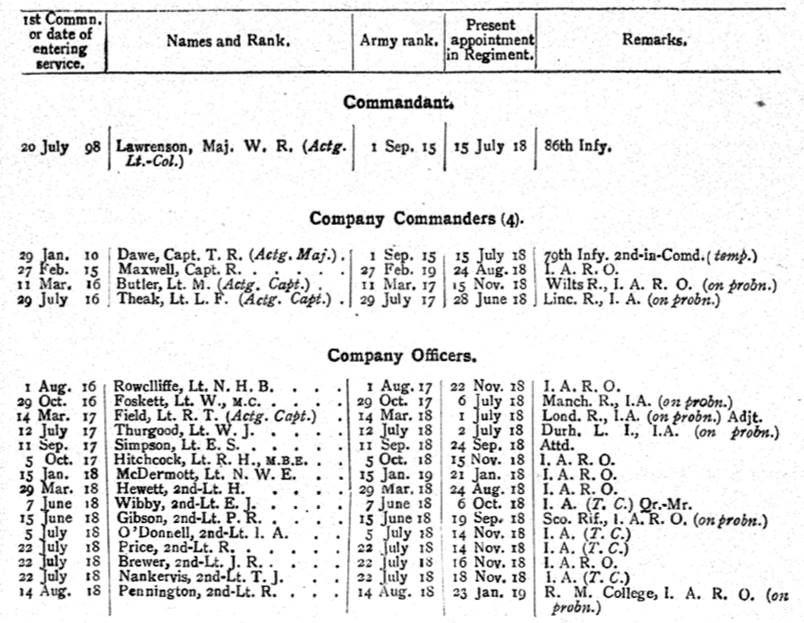This article on the 2nd Battalion 73rd Malabar Infantry aims to help you research this short-lived unit of the Indian Army and those who served with it. I have written a separate article for the 73rd Carnatic Infantry and a series of guides to help you research those who served in the Indian Army during the war:
The 2nd Battalion 73rd Malabar Infantry
Lineage: The 2nd Battalion 73rd Malabar Infantry was formed at Cannanore, now Kannur in the present-day Indian state of Kerala on 6 June 1918. The Battalion was disbanded on 8 October 1921. For a history of the Regiment’s lineage, see my page on the 1st Battalion 73rd Carnatic Infantry.
Class Composition of Battalion in 1919: 1 Company of Mapillas, 1 Company of Tiyyans and Christians, and 2 Companies of Nayars.
The 2nd Battalion 73rd Malabar Infantry was a short-lived Indian infantry battalion formed at Cannanore, now Kannur a coastal town in the present day Indian state of Kerala on 6 June 1918. The Battalion was one of numerous war-raised infantry battalions which were formed during the war on account of the expansion of the Indian Army. It recruited Mapillas, Tiyyans and Nayars from the local area into its ranks. Due to the martial races theory which predominated the Indian Army at the time, these groups were only recruited in small numbers.
The 2nd Battalion 73rd Malabar Infantry’s first commanding officer was Acting Lieutenant-Colonel William Ralph Lawrenson, who was appointed from the 86th Carnatic Infantry on 15 July 1918. The excerpt below from the April 1919 Indian Army List shows the British officers serving with the Battalion. Only two were commissioned pre-war which is typical of a war-raised Indian infantry battalion. Most of the officers were either on probation (on probn.) or from the Indian Army Reserve of Officers (I.A.R.O.).
Instruction and Training: Training in this unit is very backward. There is a shortage of Instructors, and some of the Instructors, particularly in physical training are inefficient. This is reflected in the way the men stand in the ranks.
Musketry: Being advanced as rapidly as possible now.
Marching: Not good, there appears to be a difficulty in getting men to keep step.
Physique: Variable. Some of the Nayars have very poor physique.
Physical Training: Not good. Shortage of good instructors. Men stand too stiffly, and their position at “Attention” is incorrect.
Arms and Equipment: Complete and in good order.
Discipline: No serious breaches of discipline. On arrival there were signs of slack discipline in camp, but much improvement has been made.
Documents and Records: Accounts correctly kept. Other books not satisfactory. Company books are full of uninitialled alterations.
General Observations: The turn out at the inspection was good. Drill is very backward and steps are being taken to lend instructors to the Battalion. Training of specialists is receiving attention.
There appears to be no fixed stoppage from the men for messing and the Government allowance of 10 annas [an anna was 1/16 of a Rupee] a man is not made the most of. Food is lacking in quality. With good feeding and properly supervised physical training the general physique of the men would improve.
Keeping of books and records leaves much room for improvement.
Lieutenant-General Charles Alexander Anderson, General Officer Commanding Southern Command, reported the following on 28 April 1919:
I have only seen this battalion passing in a troop train. The men appeared slack and lacking in discipline (17th November 1918). There were some cases of indiscipline in the battalion in the cold weather of 1918. The unit is still evidently a very backward one and requires much attention on the part of the Brigade Commander on most points.
Major-General William Cross-Barratt, Commanding 9th (Secunderabad) Division wrote on 31 March 1919:
An unsatisfactory new unit. Sufficient progress not made despite outside assistance. British officers seem capable, but do not get good results. Good deal of lack of progress is due to inexperienced and incompetent Indian officers. Men are good material and should make a fine battalion. Classification unsatisfactory.
In the April 1920 Indian Army List, the 2nd Battalion 73rd Malabar Infantry was stationed at Bellary, now Ballari in the present-day Indian state of Karnataka. The Battalion was under the command of Lieutenant-Colonel Henry Anthony Carleton who was appointed on 21 April 1919 and was serving as part of the 9th (Secunderabad) Division, though it wasn’t part of a brigade. By June 1920, the Battalion had been reduced to two companies and by December, the unit was preparing to serve overseas. In the July 1921 Indian Army List, the Battalion was serving overseas with its Depot at Cannanore. The 2nd Battalion 73rd Malabar Infantry was disbanded on 8 October 1921.
War Diaries of the 2nd Battalion 73rd Malabar Infantry
There are no war diaries for the 2nd Battalion 73rd Malabar Infantry.
Further Sources for the 2nd Battalion 73rd Malabar Infantry
For information regarding British and Indian officers who served with the 2nd Battalion 73rd Malabar Infantry, the Indian Army List should be consulted. There is only one confidential report for the Battalion held at the British Library: Confidential review reports on Indian Army units, depots, British officers, etc. for 1918-1919: IOR/L/MIL/7/17030. This report also contains the annual confidential reports of the British officers who served with the Battalion that year.
